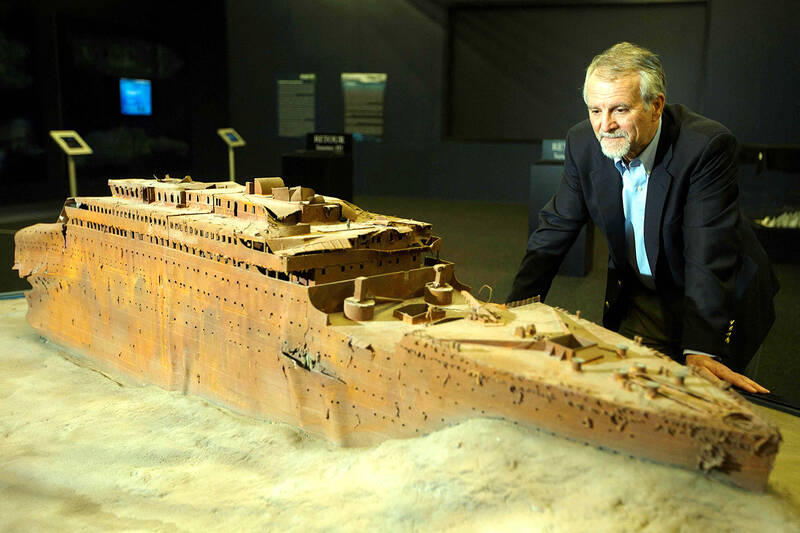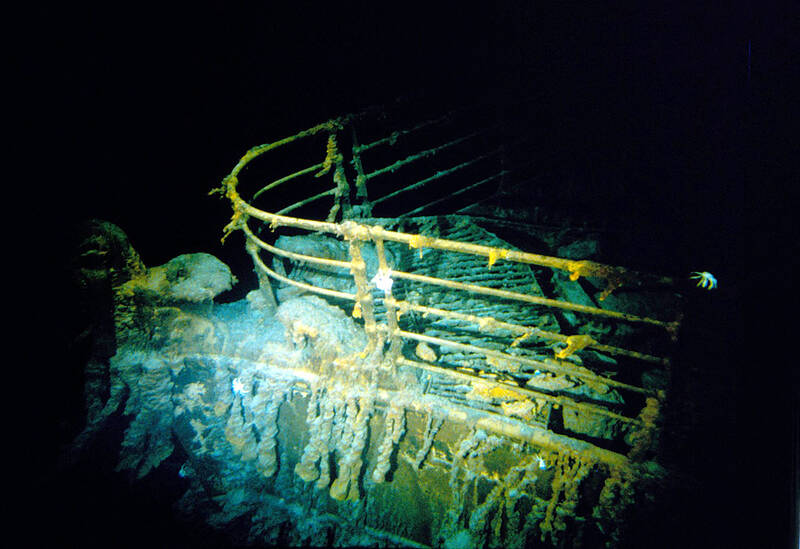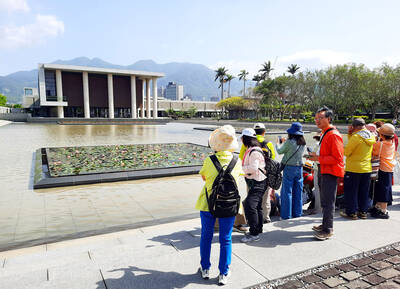Since it sank on its maiden voyage more than a century ago, the Titanic has maintained an unshakeable grip on the public imagination.
A monument to the technological progress of its time — and the hubris of men who thought they had built an unsinkable ship — one of the world’s deadliest ocean disasters has inspired books, blockbuster movies, stage productions and countless adventurers who want to see what happened when the luxury liner hit an iceberg.
Among them, the wealthy passengers and crew of a submersible that vanished Sunday in the North Atlantic Ocean on their way to visit the seabed wreck, on a US$250,000 ticket.

Photo: AFP
An all-hands search and rescue operation to find their tiny sub before the oxygen runs out was taking place Wednesday as the world watched and waited.
PALACE OF LUXURY
RMS Titanic set sail in April 1912 from Southampton, England bound for New York.

Photo: AFP
At the time, it was the largest ship ever built, a vast floating palace of luxury, where first-class passengers had the run of a gymnasium, squash court, swimming pool and top-notch dining options, or could retire to their lavish cabins where a staff of hundreds waited on their every whim.
Below decks, poor migrants were crammed into steerage quarters, desperate to get to the promise of the New World.
Late on April 14, the Titanic — carrying 2,224 passengers and crew — hit an iceberg, denting and buckling the hull and allowing water to rush in.
As compartments flooded, the 269-meter (883-foot) vessel began sinking, bow first.
There were not enough lifeboats for everyone on board, and the harried crew did not know how to deploy them; some were dispatched just half full.
Hours after she began tipping up, the huge ship snapped in two, and plunged into the depths.
Passengers who had not made it into the limited number of lifeboats perished within minutes in the freezing water.
Around 1,500 people died in the disaster. Just 700 were picked up by RMS Carpathia, a transatlantic steamship that had answered the Titanic’s distress calls.
WRECK
The exact location of the wreck remained a mystery for 70 years until a Franco-American expedition discovered where it lay, 3,700 meters below the waves.
Footage from the ocean bed shows the two halves of the ship surrounded by a huge debris field — furniture, shoes, plates and other detritus ejected from the vessel as it sank.
In the years since it was rediscovered, the wreck has been visited by researchers, explorers, tourists and filmmakers.
One of its most famous visitors was director James Cameron, whose 1997 smash Titanic starred Leonardo DiCaprio and Kate Winslet as passengers who fall in love.
The movie is known as much for Celine Dion’s hit My Heart Will Go On as for a scene in which DiCaprio’s character, Jack, rescues Winslet’s Rose by pushing her aboard a floating door, sacrificing himself in the process.
Such is the film’s enduring popularity, even a quarter century later debates and theories continue to swirl around whether there was actually room enough for Jack on the makeshift raft.
It is just one example of how the story of the Titanic “never seems to end for people,” Cameron told a press conference held for the 25th anniversary re-release earlier this year.
“The Titanic has this kind of enduring, almost mythic, novelistic quality. And it has to do with, I think, love and sacrifice and mortality,” he said.
TOURISM
Auctions of Titanic memorabilia and artifacts remain popular, with an embroidered pink coat Winslet wore in filming the 1997 movie and a letter written by a Uruguayan passenger who died in the disaster both going under the hammer next week in separate sales.
The violin used by bandleader Wallace Hartley to play hymns on deck as the great ship went down — a reminder of the Titanic’s final moments — sold in 2013 for US$1.7 million.
Tom Zaller, who runs the company behind “Titanic: The Exhibition,” a collection of artifacts and interactive experiences that has toured the world, said people find the ship fascinating.
“It’s such an incredibly human story,” he said. “We all can relate to some passenger on board that ship, right, because they call it the ship of dreams.”
While for many, the Titanic is a historical curiosity — as distant from today as the Parthenon or Pompeii — for descendents of those who perished there is something distasteful about ultra-wealthy tourists spending heavily to visit the wreck.
“I think it’s disgusting, quite honestly,” 69-year-old John Locascio, whose two uncles died in the tragedy, told The Daily Beast.
“They died a horribly tragic death. Just leave the bodies resting,” Locascio added. “They don’t want people down to see them. Just leave well enough alone.”

When the South Vietnamese capital of Saigon fell to the North Vietnamese forces 50 years ago this week, it prompted a mass exodus of some 2 million people — hundreds of thousands fleeing perilously on small boats across open water to escape the communist regime. Many ultimately settled in Southern California’s Orange County in an area now known as “Little Saigon,” not far from Marine Corps Base Camp Pendleton, where the first refugees were airlifted upon reaching the US. The diaspora now also has significant populations in Virginia, Texas and Washington state, as well as in countries including France and Australia.

On April 17, Chinese Nationalist Party (KMT) Chairman Eric Chu (朱立倫) launched a bold campaign to revive and revitalize the KMT base by calling for an impromptu rally at the Taipei prosecutor’s offices to protest recent arrests of KMT recall campaigners over allegations of forgery and fraud involving signatures of dead voters. The protest had no time to apply for permits and was illegal, but that played into the sense of opposition grievance at alleged weaponization of the judiciary by the Democratic Progressive Party (DPP) to “annihilate” the opposition parties. Blamed for faltering recall campaigns and faced with a KMT chair

Article 2 of the Additional Articles of the Constitution of the Republic of China (中華民國憲法增修條文) stipulates that upon a vote of no confidence in the premier, the president can dissolve the legislature within 10 days. If the legislature is dissolved, a new legislative election must be held within 60 days, and the legislators’ terms will then be reckoned from that election. Two weeks ago Taipei Mayor Chiang Wan-an (蔣萬安) of the Chinese Nationalist Party (KMT) proposed that the legislature hold a vote of no confidence in the premier and dare the president to dissolve the legislature. The legislature is currently controlled

Dull functional structures dominate Taiwan’s cityscapes. But that’s slowly changing, thanks to talented architects and patrons with deep pockets. Since the start of the 21st century, the country has gained several alluring landmark buildings, including the two described below. NUNG CHAN MONASTERY Dharma Drum Mountain (法鼓山, DDM) is one of Taiwan’s most prominent religious organizations. Under the leadership of Buddhist Master Sheng Yen (聖嚴), who died in 2009, it developed into an international Buddhist foundation active in the spiritual, cultural and educational spheres. Since 2005, DDM’s principal base has been its sprawling hillside complex in New Taipei City’s Jinshan District (金山). But